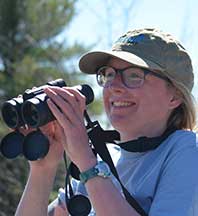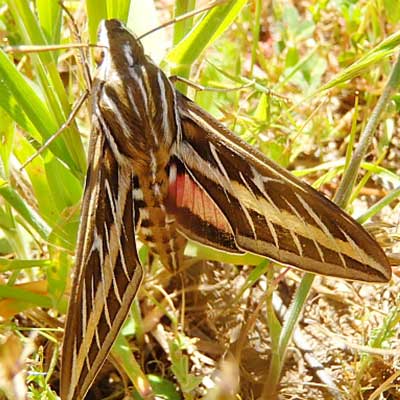Powerful Pollinators
Week of June 27 – July 3, 2021
 by Anna Stunkel, Environmental Educator
by Anna Stunkel, Environmental Educator
As summer is beginning, it’s an exciting time to keep an eye out for insect pollinators. Busy bees, butterflies, moths, beetles, ants, and more are all crucial helpers in the process of pollination, fertilizing plants and allowing them to create seeds. Many of the fruits and vegetables that you eat wouldn’t exist without our pollinator friends. As insects visit flowers to feed, pollen sticks to them and is then transferred to other flowers. For example, have you ever seen a fuzzy bumblebee covered in yellow dust? That’s pollen!
Bees also have long hairs on their legs that help to hold their pollen cargo in place. While some of this pollen is carried back to the hive for food, a little of it also falls onto other flowers. Next time you see a bee hard at work visiting flowers, try to spot the little yellow pollen “saddlebags” on its legs. From iridescent green to striped black and yellow, bees are a very diverse group of insects. In New York, there are over 400 species of them!
Beautiful butterflies are pollinators, too. Summer is a great time to look for them, and there are many different colorful species that can be found here in Central New York. Next time you see a butterfly or moth visiting a flower, notice the long tongue that it uses like a straw to sip nectar. While many moths are nocturnal (active at night), you can see some of them visiting flowers during the daytime, such as the White-lined Sphinx Moth pictured here. Hummingbird moths are also common visitors to gardens and meadows. They look and act a lot like hummingbirds, zipping through the air and feeding on flower nectar, hence their name.
Many other insects visit flowers to feed, too, such as beetles, flies, and ants. Next time you go for a summer walk, try taking a closer look at the flowers around you. Can you spot any insects on them? Some of these insect visitors might be tiny, while others are big and brightly colored. Take a moment to watch them feed, and you can even try to follow them from flower to flower. If you have a garden, you can help pollinators by planting native plants, and you can always stop by to explore the trails and gardens of Baltimore Woods. To learn more about pollinators and how you can help them, take a look at these resources:
https://www.nrcs.usda.gov/wps/portal/nrcs/detail/ny/plantsanimals/?cid=nrcs144p2_027389





